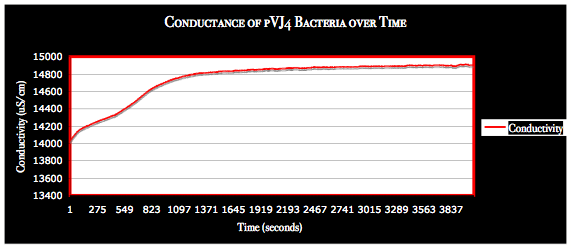Team:Brown/Project/Analysis
From 2008.igem.org
(→Optical Density) |
|||
| Line 2: | Line 2: | ||
==Optical Density== | ==Optical Density== | ||
| - | |||
| - | |||
| - | |||
| - | |||
| - | |||
| - | |||
| - | |||
| - | |||
| - | |||
| - | |||
| - | |||
| - | |||
| - | |||
| - | |||
| - | |||
| - | |||
| - | |||
| - | |||
| - | |||
| - | |||
| - | |||
| - | |||
| - | |||
| - | |||
| - | |||
| - | |||
| + | In order to test the mechanism of the SRRz lysis cassette, we took optical density measurements as cell lysis occurred. The construct we used for testing was contained on the pVJ4 plasmid. This plasmid was obtained from the Mekalanos lab at HMS and contained the SRRz gene cassette in a pBAD18 plasmid. | ||
| + | Initially we introduced arabinose to the culture of cells and allowed the cultures to sit at room temperature for several hours and measured the optical density before and after the cells lysed. 0.2% arabinose by mass was added to the cultures. | ||
| Line 39: | Line 15: | ||
| + | This data indicates that significant lysis occurs over a period of a few hours, confirming that the lysis cassette functions as predicted. | ||
| + | Next, we wanted to test the amount of time required for lysis to occur. We added 0.2% by volume of an arabinose stock solution to cell cultures and measured the optical densities of the cultures at certain distinct time points. The following graphs exhibit optical density trends during gene expression and resulting cell lysis and cell wall degradation. The first graph shows optical density and correlates that data to a predicted change in resistance that should occur as the cells lyse. Resistance and Optical Density is expected to increase slightly within the first hour due to the continued cell growth after induction by .2% Arabinose. | ||
| + | [[Image:Od measurements cell lysis test 2.png|left|thumb|500px|Optical Density WRT Time]] | ||
| + | [[Image:Optical density measurement test 1.png|left|thumb|500px|Optical Density WRT Time]] | ||
| + | |||
| + | Optical density of the cell cultures significantly dropped between 1 and 2 hours after induction, signifying the expression of the lysis gene cassette. Notice that optical density increases slightly within the first hour of the test, due to continued cell growth before the lytic event. The predicted change in resistance reflects this period of cell growth. | ||
| + | Each culture was originally grown into the stationary phase and then diluted to the mid-log phase. The E. coli cells experience greatest growth in the Mid-Log phase. Arabinose was added while cells were in this phase which provided the quickest protein expression and resulting lysis. | ||
==NaCl Testing== | ==NaCl Testing== | ||
Revision as of 06:20, 29 October 2008
Optical DensityIn order to test the mechanism of the SRRz lysis cassette, we took optical density measurements as cell lysis occurred. The construct we used for testing was contained on the pVJ4 plasmid. This plasmid was obtained from the Mekalanos lab at HMS and contained the SRRz gene cassette in a pBAD18 plasmid. Initially we introduced arabinose to the culture of cells and allowed the cultures to sit at room temperature for several hours and measured the optical density before and after the cells lysed. 0.2% arabinose by mass was added to the cultures.
This data indicates that significant lysis occurs over a period of a few hours, confirming that the lysis cassette functions as predicted.
Next, we wanted to test the amount of time required for lysis to occur. We added 0.2% by volume of an arabinose stock solution to cell cultures and measured the optical densities of the cultures at certain distinct time points. The following graphs exhibit optical density trends during gene expression and resulting cell lysis and cell wall degradation. The first graph shows optical density and correlates that data to a predicted change in resistance that should occur as the cells lyse. Resistance and Optical Density is expected to increase slightly within the first hour due to the continued cell growth after induction by .2% Arabinose.
NaCl Testing
Salt concentrations originally tested are listed below. Further tests are to be run where the greatest resistance jump occurred to determine the exact concentration needed to see a significant resistance decrease due to cell lysis. Molarity (M):
Resistance Testing
Conductivity Testing
|
 "
"


